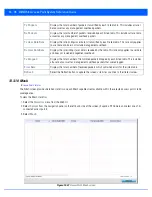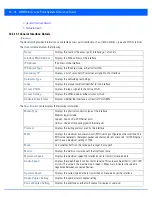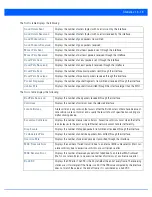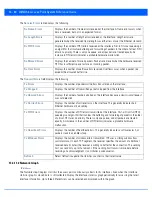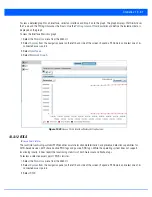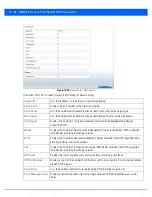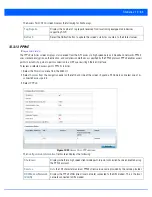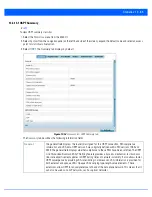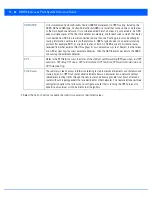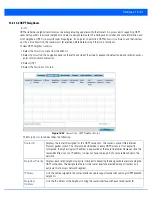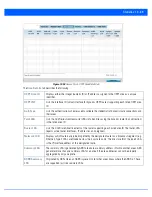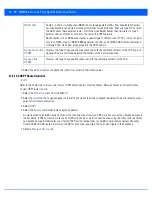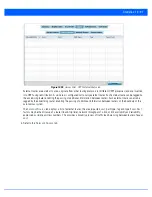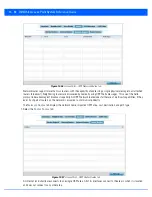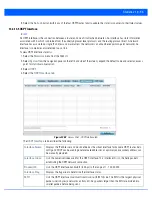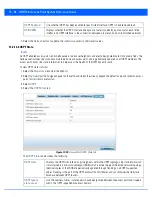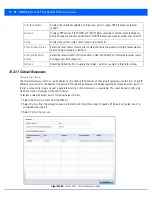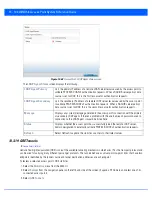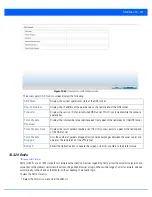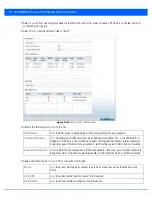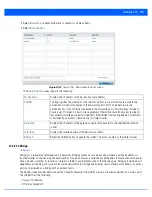
13 - 90 WiNG 5.6 Access Point System Reference Guide
5. Select the
Refresh
button to update the statistics counters to their latest values.
13.3.14.4 OSPF Route Statistics
OSPF
Refer to the
Routes
tab to assess the status of OSPF
Border Routes, External Routes
,
Network Routes
and
Router Routes
.
To view OSPF route statistics:
1. Select the
Statistics
menu from the Web UI.
2. Select
System
from the navigation pane (on the left-hand side of the screen), expand the default node and select an access
point for statistical observation.
3. Select
OSPF
.
4. Select the
Routes
tab. Border routes display by default.
An
area border router
(ABR) connects (links) more than one area. Usually an ABR is used to connect non-backbone areas to
the backbone. If OSPF virtual links are used an ABR will also be used to connect the area using the virtual link to another
non-backbone area. Border routes use internal OSPF routing table entries to an ABR or
Autonomous System Boundary
Router
(ASBR). Border routers maintain an LSDB for each area supported. They also participate in the backbone.
5. Refer to
External Routes
tab.
NSSA LSA
Routers in a
Not-so-stubby-area
(NSSA) do not receive external LSAs from Area Border Routers,
but are allowed to send external routing information for redistribution. They use type 7 LSAs to tell
the ABRs about these external routes, which the Area Border Router then translates to type 5
external LSAs and floods as normal to the rest of the OSPF network.
Redistribution into an NSSA area creates a special type of LSA known as TYPE 7, which can exist
only in an NSSA area. An NSSA ASBR generates this LSA, and an NSSA ABR router translates it
into type 5 LSA which gets propagated into the OSPF domain.
Opaque Area link
CSUM
Displays the Type-10 opaque link area checksum with the complete contents of the LSA. Type-10
Opaque LSAs are not flooded beyond the borders of their associated area.
Opaque link
CSUM
Displays the Type-10 opaque link checksum with the complete contents of the LSA.
Summary of Contents for WiNG 5.6
Page 1: ...Motorola Solutions WiNG 5 6 ACCESS POINT SYSTEM REFERENCE GUIDE ...
Page 2: ......
Page 22: ...8 WiNG 5 6 Access Point System Reference Guide ...
Page 26: ...1 4 WiNG 5 6 Access Point System Reference Guide ...
Page 38: ...2 12 WiNG 5 6 Access Point System Reference Guide ...
Page 74: ...3 36 WiNG 5 6 Access Point System Reference Guide ...
Page 468: ...6 2 WiNG 5 6 Access Point System Reference Guide Figure 6 1 Configuration Wireless menu ...
Page 568: ...6 102 WiNG 5 6 Access Point System Reference Guide ...
Page 614: ...7 46 WiNG 5 6 Access Point System Reference Guide ...
Page 660: ...8 46 WiNG 5 6 Access Point System Reference Guide ...
Page 716: ...9 56 WiNG 5 6 Access Point System Reference Guide ...
Page 730: ...10 14 WiNG 5 6 Access Point System Reference Guide ...
Page 982: ...14 20 WiNG 5 6 Access Point System Reference Guide ...
Page 984: ...A 2 WiNG 5 6 Access Point System Reference Guide ...
Page 1046: ...B 62 WiNG 5 6 Access Point System Reference Guide ...
Page 1047: ......

